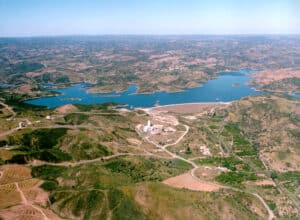Whether a relative newcomer or a lifetime citizen, we’ve all become accustomed to sunny skies. Our plans are seldom spoiled by storm clouds.
The Algarve is well known as a sunny place. The fact that the southern coast of Portugal has an average of 300 days a year of sunshine is obviously one reason why it is one of the most popular vacation and retirement destinations among people from Great Britain, where it has been known to rain much more often.
My lovely wife and I routinely watch a couple of British news stations (ITV and Channel 4) and we appreciate the contrast when the weather report comes on. First, both channels give us a glimpse of a map of the European Continent, and we get to spot our tip of the Iberian Peninsula with usually clear skies. “Clear!” I declare before they zoom in on wetter news for the British Isles. I believe that the Brit weather forecasters are required to try to fit the word sunshine into every forecast no matter how remote the possibility of such a phenomenon actually occurring.
One of my favorite phrases I’ve heard from a usually cheerful English weather person is “scattered patches of sunshine”. Doesn’t that sound hopeful and bright? Unless you consider what is surrounding those few, sparse patches.
The opposite is the case, here at the southwestern end of Europe. Residents here know that we can go months without a drop of precipitation. On the weather app on my smartphone, the daily sunny symbols continue down past the bottom edge of the screen. For vacationers, it is quite attractive to know that it probably won’t rain on any of their planned beach days or golf outings.
The obvious downside to all these clear skies is that drought conditions become a real problem with the strong possibility of wildfires igniting our eucalyptus forests and even drinking water becoming scarce. Eventually, places like golf courses seem like negative space that requires unreasonable amounts of irrigation. And yet, the Algarve is often voted the number one golf destination in Europe if not the world. That is the definition of a conundrum. The Portugal Resident will continue to report on government and community efforts to preserve water resources and renew efforts, including desalination, to enhance this fundamental resource and, naturally, good ol’Pat supports even more being done.
Whether a relative newcomer or a lifetime citizen, we’ve all become accustomed to sunny skies. Our plans are seldom spoiled by storm clouds. In fact, we have organized our lives and living spaces to the fact that we are able to be outside. My lovely wife and I have our morning coffee out on the patio most mornings and we enjoy grilling the meat portion of our dinner many evenings.
It doesn’t seem like a good idea not to have outdoor seating if you own a restaurant or café. Even on the municipal level, many concerts, fairs and festivals are held outdoors, pretty much year-round. Lovely hikes along the cliffs are much less dangerous when it isn’t raining, as are long dog walks through the fields or salt flats.
The point is, we’re not really set up for even the occasional thunderstorm. It’s nice to wake up to sunlight streaming through your curtains. It’s nice to sit out on your rooftop terrace in a lounge chair and read a book and catch some rays.
We seldom have to dash to the car or even open an umbrella, much less do both at once. If we have people visiting, even difficult in-laws or a bunch of kids, it’s no problem. We simply stuff them in the van and take them to the beach or for a walk around town or to a vineyard (the in-laws). In other words, we can’t help it – we’re spoiled.
So, what happens when it does rain? Well, the first thing we try is to be philosophical by stating emphatically “Well, we need it.” Which is almost always true. Even the most immature or self-centered among us can handle a day or two of rain as inevitable and, yes, even necessary.
However, all of our goodwill and reasonableness get tested when we have to endure rare rainy spells of more than a few days. Take our most recent month of March, for instance. It has rained over half the time with a few days in a row, especially at the end of the month through Easter.
Portugal rain does tend to be sporadic, meaning not all day long, with actual sunny spells and seldom prolonged downpours (that’s why the dams don’t fill up as much as some ill-informed people think they should).
We did have a storm recently that even had a name – “Nelson” -and it did cause some local flooding. During all this fog, clouds, and occasional heavy showers rattling through, some of us got a little depressed, impatient, irritable even.
February was the warmest on the mainland in the past 93 years
How soon we forget. February of this year was absolutely beautiful, with few, if any, days of recorded precip. Everybody was talking about an early Spring and flowers were blooming everywhere. In fact, it was reported right here in “the Ressie” that February was the warmest on the mainland in the past 93 years, with January being the third hottest on record. So, we’ve actually had it good lately, just not that recently.
Over the past 20 years, the month with the highest average rainfall has been January, with an average rainfall of 171.5 mm. December is a very close second at 170 mm. On average, August has been the driest month, sometimes with zero precipitation recorded.
Our rather wet March this year doesn’t even make the top five months during an average year that has about 108 mm come tumbling down. April showers at 106 mm don’t work here because we’ve already had plenty of flowers (primarily but not limited to corn buttercups and crown daisies) blooming prolifically in the fields and along the highways and byways of our lovely land.
The biggest drop in average precipitation is between June at 57 mm and July with no more than 15mm. Then, after maybe none in August, we can climb up to September with a possible 51 mm and then way up to 130mm in October and 166mm in November.
I know that the previous paragraph has been virtually meaningless to many of my American readers who have resisted the metric system and still measure rainfall in inches. It’s also not that helpful when you learn that one-inch equals 25.4 millimeters (get out the calculators!).
Anyway, for your information, Portugal has averaged 859.03 mm from 1901 to 2022. The all time high was relatively recently at 1333.1 mm in 2010 and a hard-to-believe low of 571.94 in 1944. We’ve been at just a bit above average the past few years hovering in the low to mid 900s.
So yeah, a leading reason most of us have moved here to retire, or become internet nomads or citizens of the world is not to simply escape a “maga” world of discord and petty bickering but rather to enjoy some very pleasant weather, along with an affordable standard of living and some really good inexpensive wine. It never gets that cold here in the Algarve, Celsius or Fahrenheit, and it hardly ever rains too much.
By Pat the Expat
|| features@algarveresident.com
For the previous 10 years, Pat lived in Panama which used to be rated above Portugal as a top retirement destination (but not any more), where he wrote a column for a tourist publication.

























